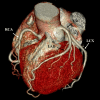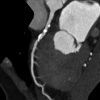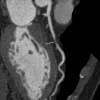Characteristics of coronary artery disease in symptomatic type 2 diabetic patients: evaluation with CT angiography
- PMID: 21067585
- PMCID: PMC2992482
- DOI: 10.1186/1475-2840-9-74
Characteristics of coronary artery disease in symptomatic type 2 diabetic patients: evaluation with CT angiography
Abstract
Background: Coronary artery disease (CAD) is a common and severe complication of type 2 diabetes mellitus (DM). The aim of this study is to identify the features of CAD in diabetic patients using coronary CT angiography (CTA).
Methods: From 1 July 2009 to 20 March 2010, 113 consecutive patients (70 men, 43 women; mean age, 68 ± 10 years) with type 2 DM were found to have coronary plaques on coronary CTA. Their CTA data were reviewed, and extent, distribution and types of plaques and luminal narrowing were evaluated and compared between different sexes.
Results: In total, 287 coronary vessels (2.5 ± 1.1 per patient) and 470 segments (4.2 ± 2.8 per patient) were found to have plaques, respectively. Multi-vessel disease was more common than single vessel disease (p < 0.001), and the left anterior descending (LAD) artery (35.8%) and its proximal segment (19.1%) were most frequently involved (all p < 0.001). Calcified plaques (48.8%) were the most common type (p < 0.001) followed by mixed plaques (38.1%). Regarding the different degrees of stenosis, mild narrowing (36.9%) was most common (p < 0.001); however, a significant difference was not observed between non-obstructive and obstructive stenosis (50.4% vs. 49.6%, p = 0.855). Extent of CAD, types of plaques and luminal narrowing were not significantly different between male and female diabetic patients.
Conclusions: Coronary CTA depicted a high plaque burden in patients with type 2 DM. Plaques, which were mainly calcified, were more frequently detected in the proximal segment of the LAD artery, and increased attention should be paid to the significant prevalence of obstructive stenosis. In addition, DM reduced the sex differential in CT findings of CAD.
Figures






Similar articles
-
Comparison of atherosclerotic plaque burden and composition between diabetic and non diabetic patients by non invasive CT angiography.Int J Cardiovasc Imaging. 2009 Oct;25(7):717-23. doi: 10.1007/s10554-009-9483-9. Epub 2009 Jul 26. Int J Cardiovasc Imaging. 2009. PMID: 19633998
-
Application of Dual-Source CT Coronary Angiography in Type 2 Diabetic Patients with Symptomatic Coronary Heart Disease.Curr Vasc Pharmacol. 2017;15(1):59-65. doi: 10.2174/1570161114666160914175627. Curr Vasc Pharmacol. 2017. PMID: 27633455
-
Diabetes as an independent predictor of high atherosclerotic burden assessed by coronary computed tomography angiography: the coronary artery disease equivalent revisited.Int J Cardiovasc Imaging. 2013 Jun;29(5):1105-14. doi: 10.1007/s10554-012-0168-4. Epub 2012 Dec 13. Int J Cardiovasc Imaging. 2013. PMID: 23239217
-
Serial coronary computed tomography angiography-verified coronary plaque progression: comparison of stented patients with or without diabetes.Cardiovasc Diabetol. 2019 Sep 24;18(1):123. doi: 10.1186/s12933-019-0924-z. Cardiovasc Diabetol. 2019. PMID: 31551077 Free PMC article.
-
Diagnostic Performance of Hybrid Cardiac Imaging Methods for Assessment of Obstructive Coronary Artery Disease Compared With Stand-Alone Coronary Computed Tomography Angiography: A Meta-Analysis.JACC Cardiovasc Imaging. 2018 Apr;11(4):589-599. doi: 10.1016/j.jcmg.2017.05.020. Epub 2017 Aug 16. JACC Cardiovasc Imaging. 2018. PMID: 28823745 Free PMC article.
Cited by
-
Noninvasive assessment of the carotid and cerebrovascular atherosclerotic plaques by multidetector CT in type-2 diabetes mellitus patients with transient ischemic attack or stroke.Diabetol Metab Syndr. 2013 Feb 26;5(1):9. doi: 10.1186/1758-5996-5-9. Diabetol Metab Syndr. 2013. PMID: 23443053 Free PMC article.
-
Comparative analysis of Nε-carboxymethyl-lysine and inflammatory markers in diabetic and non-diabetic coronary artery disease patients.World J Diabetes. 2023 Dec 15;14(12):1754-1765. doi: 10.4239/wjd.v14.i12.1754. World J Diabetes. 2023. PMID: 38222780 Free PMC article.
-
Identification of noncalcified plaque in young persons with diabetes: an opportunity for early primary prevention of coronary artery disease identified with low-dose coronary computed tomographic angiography.Acad Radiol. 2012 Jul;19(7):889-93. doi: 10.1016/j.acra.2012.03.013. Epub 2012 Apr 26. Acad Radiol. 2012. PMID: 22542200 Free PMC article.
-
Association between coronary artery atherosclerosis and plasma glucose levels assessed by dual-source computed tomography.J Thorac Dis. 2018 Nov;10(11):6050-6059. doi: 10.21037/jtd.2018.10.62. J Thorac Dis. 2018. PMID: 30622776 Free PMC article.
-
Anxiety Level and Cardiac Autonomic Modulations in Coronary Artery Disease and Cardiac Syndrome X Patients.PLoS One. 2017 Jan 9;12(1):e0170086. doi: 10.1371/journal.pone.0170086. eCollection 2017. PLoS One. 2017. PMID: 28068419 Free PMC article.
References
-
- Steiner G. Atherosclerosis, the major complication of diabetes. Adv Exp Med Biol. 1985;189:277–297. - PubMed
-
- Djaberi R, Beishuizen ED, Pereira AM, Rabelink TJ, Smit JW, Tamsma JT, Huisman MV, Jukema JW. Non-invasive cardiac imaging techniques and vascular tools for the assessment of cardiovascular disease in type 2 diabetes mellitus. Diabetologia. 2008;51:1581–1593. doi: 10.1007/s00125-008-1062-4. - DOI - PMC - PubMed
-
- Budoff MJ, Achenbach S, Blumenthal RS, Carr JJ, Goldin JG, Greenland P, Guerci AD, Lima JA, Rader DJ, Rubin GD, Shaw LJ, Wiegers SE. American Heart Association Committee on Cardiovascular Imaging and Intervention; American Heart Association Council on Cardiovascular Radiology and Intervention; American Heart Association Committee on Cardiac Imaging, Council on Clinical Cardiology. Assessment of coronary artery disease by cardiac computed tomography: a scientific statement from the American Heart Association committee on cardiovascular imaging and intervention, council on cardiovascular radiology and intervention, and committee on cardiac Imaging, council on clinical cardiology. Circulation. 2006;114:1761–1791. doi: 10.1161/CIRCULATIONAHA.106.178458. - DOI - PubMed
MeSH terms
LinkOut - more resources
Full Text Sources
Medical
Miscellaneous

